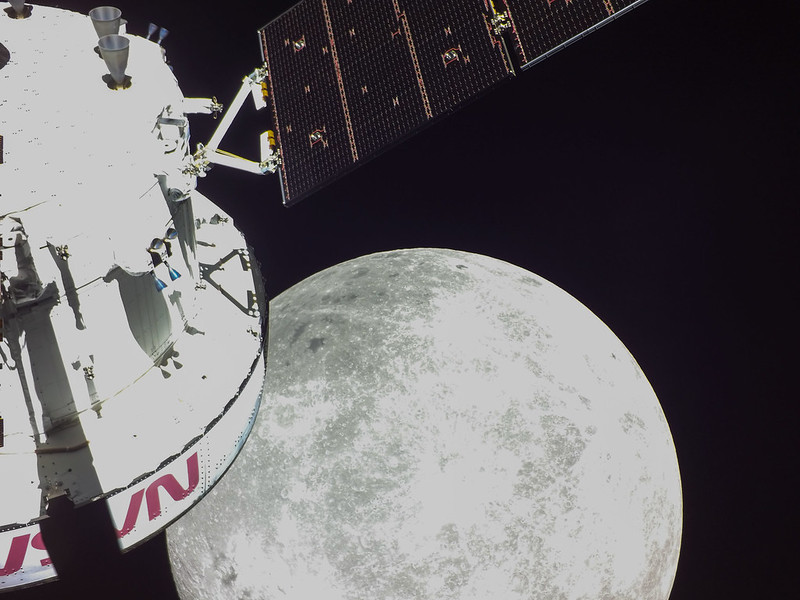The Orion spacecraft made its first close flyby of the Moon on Monday, November 21, coming as close as 81 statute miles (130 km) from the lunar surface. As the Artemis 1 mission’s uncrewed spacecraft flew past the far side of the Moon, Orion’s orbital maneuvering system engine fired for 2 minutes and 30 seconds to successfully put the capsule into the desired orbit for the mission, called a distant retrograde orbit around the Moon.
“This burn is setting Orion up to orbit the Moon, and is largest propulsive event so far, as Artemis is hunting the Moon,” said Mike Sarafin, Artemis Mission Manager at a briefing on Monday.
The engine burn, called an outbound powered flyby burn, is the first of two maneuvers required to enter the so-called distant retrograde orbit around the Moon. The next burn comes on Friday, Nov. 25, using the engines on the European Service Module. Orion will remain in this orbit for about a week to test spacecraft systems. The distant retrograde will take Orion 40,000 miles (64,000 km) past the Moon. Orion’s greatest distance from the Earth will be Monday, Nov. 28 at 3:05 p.m. CST at more than 268,500 miles (432,000 km). Orion’s greatest distance from the Moon will be on Friday, Nov. 25 at 3:53 p.m. CST at more than 57,250 miles (92,000 km). This is the farthest any human-rated spacecraft has flown beyond the Moon.
Sarafin said the mission teams has had a chance to review the performance of the SLS rocket, the spacecraft and the ground systems for the Artemis I mission. The results, he said, were “eye watering,” meaning everything has met or exceeded expectations.
“We haven’t’ seen a single thing on the rocket or spacecraft that would cause us to question any portion of the mission,” Sarafin said. “This is largely a greenlight flight. The vehicle systems are very clean, but we are working a few ‘funnies’ – nothing that puts any constraints on the mission, just that some things were operating differently than expected. Overall, the mission continues to proceed as planned.”
During the flyby, cameras on board the spacecraft sent back stunning imagery of the Moon, with Earth in the distant background.
“An Earthrise of our pale blue dot and its 8 billion human inhabitants now coming into view,” Mission Control commentator Sandra Jones said on NASA TV as footage was received from Orion.
“We didn’t expect to get livestream video like we did,” said Judd Frieling, the Ascent and Entry Flight Director for Artemis 1, “but as part of testing the system, we were seeing how far we can press the bandwidth limitations. From this point forward, when we have the bandwidth available, we will broadcast the livestream from the mission.”

The Artemis 1 flight launched on November 16 and is the first mission in 50 years where a human capable spacecraft is at the Moon. NASA hopes to use Orion, SLS and other yet to be built hardware, such as a Moon lander built by SpaceX — to send astronauts back to the lunar surface. That first lunar landing could launch as soon as 2025. Artemis 1 is testing out much of the technology that will be needed for future flights.
Orion will return to Earth about 25 days after launch, and splashdown of Orion is currently slated for December 11. Using the cameras on the European Service Module’s solar arrays, engineers have been able to assess the exterior or Orion and have deemed it to be in great shape. Therefore, Orion has already been cleared for re-entry.
Sarafin said that on December 5, teams will meet to decide when and where to deploy the recovery forces, at joint effort between the US Navy and NASA. The recovery zone will be in the Pacific Ocean, but the exact landing site will be decided based on a whole host of factors, most importantly the weather.
Keep tabs on the flight at NASA’s Artemis blog.
The post Artemis I has Completed its First Flyby of the Moon appeared first on Universe Today.
No comments:
Post a Comment